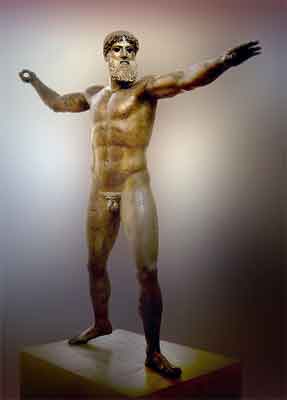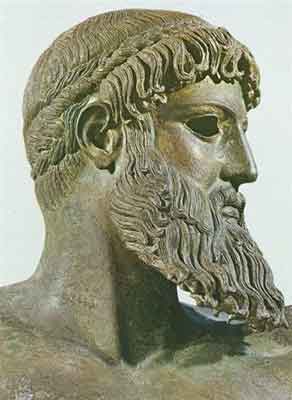The Zeus of Artemision is a rather grand bronze statue that serves as an example of fifth century sculpture like the Diskobolos. It was recovered from a Roman shipwreck near Cape Artemesion in 1928 which means that the Romans most likely intended to transport it from Greece to Rome but apparently failed in doing so. This may actually stand as the only reason the sculpture has made it to us today, however, as many other original bronze statues of the time have long ago been melted down or otherwise lost from history. Although the exact identity of the sculptor is unknown, many attribute this work to Kalamis and date the piece to about 460 BCE. It is also widely believed to be a representation of Zeus, but it is actually unknown whether the sculpture is of Zeus or Poseidon and whether the object it originally brandished in its right hand was a thunderbolt or a trident, depending on who it is supposed to be.
The piece is slightly over life-size at 2.09 meters and demonstrates the severe style of the fifth century. Zeus appears to be paused in action with his stance, although no muscles are noticeably contracted. He stands with most of his weight shifted to one foot while the other lightly touches the ground and his arms are extended showing an openness that is only possible because he is made of bronze rather than stone. Although he appears properly balanced from a frontal view, he is actually rather flat and not nearly as dimensional as is originally presumed. Despite this, Zeus’s head harbors great detail and his hair and beard are intricately carved. His eyebrows were originally made of silver, his lips of copper, and his eyes, which are now completely missing, of some other material. Overall there is a power evident in the sculpture that only a god could possess, whether this actually is a depiction of Zeus or rather of the god of the sea.
Today the Zeus of Artemision is displayed in the National Archaeological Museum in Athens.

Zeus of Artemision

Detail of Zeus of Artemision's head
Works Cited:
Biers, William R. The Archaeology of Greece. Ithaca: Cornell University Press, 1996.
Whitley, James. The Archaeology of Ancient Greece. Cambridge: Cambridge University Press, 2001.
--Mike Bohl
Posted at Dec 12/2007 06:19PM:
keffie: Nice work!
Posted at Dec 13/2007 11:50PM:
Harry Anastopulos: I'm really glad someone did this sculptural piece as a glossary entry. The sight of the Zeus of Artemision is awe-inspiring and certainly one of my favorites from this course. The amount of detail is impressive...it was really neat to see how sculpture changed throughout the span of ancient Greek history.
